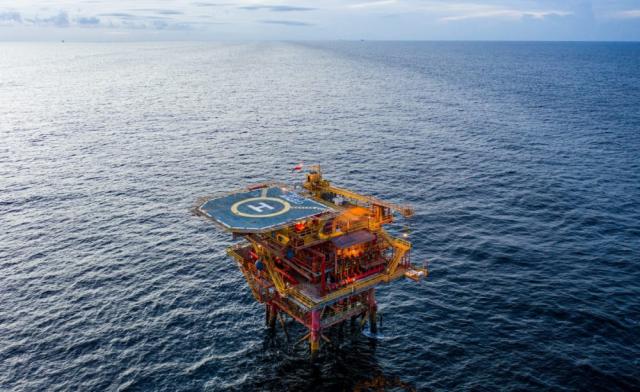
bpTT announced in May the return of the Joe Douglas jackup rig which will arrive in Trinidad in September and begin drilling operations in the fourth quarter. A consortium composed of BP nd Repsol, the company operates 16 offshore facilities and two onshore processing facilities and accounts for approximately 50% of Trinidad and Tobago’s natural gas production. (Source: bpTT / BP Plc)
Trinidad and Tobago’s natural gas production is back on the decline after two consecutive months on the uptick.
Gas production reached 2.77 Bcf/d in February, down 4% sequentially compared to January, according to the most recent data published by the country’s Ministry of Energy and Energy Industries (MEEI).
The twin-island gas producer’s production in November 2021 fell month-over-month before rising in December 2021 and January 2022. However, production in February is down 3% compared to the same year ago month, according to the MEEI data, but still higher than the low point last year of 2.34 Bcf in August 2021.
Looking forward, Trinidad’s gas production is still expected to rise to reach 3.28 Bcf/d by 2024, MEEI head Stuart Young said earlier this month, citing numerous projects slated to come online.
In recent years Trinidad has struggled to stop declines in gas reserves and production due to a lack of incentives, which Young said the government looks to address. The government has been slow to alter its fiscal regime amid the ongoing reality that the country’s gas reserves could run out in less than 10 years, according to data provided in BP’s Statistical Review of World Energy.
Lower gas production has already impacted Trinidad’s LNG, methanol, ammonia and sectors, which are the main gas dependent export industries. While the gas exporters are riding the wave of high commodity prices due to Russia’s invasion in the Ukraine, their unexpected financial gains shouldn’t mask the underlining headwinds preventing them from boosting gas production.
Limited Gas Producers
Seven companies are responsible for Trinidad and Tobago’s gas production. Alarmingly, of the companies which include bpTT, EOG Resources Inc., Shell Plc, BHP (now Woodside Energy Group Ltd.), Perenco, DeNovo Energy and Heritage Petroleum Co. Ltd.—Trinidad’s newest state-owned oil and gas company—only the latter was able to keep production flat in February compared to the prior month.
bpTT, a consortium composed of BP Plc (70% interest) and Repsol SA (30%), operates 16 facilities offshore the Caribbean country and two onshore processing facilities, and is Trinidad’s largest gas producer. In February, bpTT was responsible for 50% of Trinidad’s gas production, followed thereafter by Shell (21%), BHP (13%), EOG (12%) and Denovo (2%).
Trinidad’s LNG sector continues to be the largest user of the country’s gas production, according to MEEI data. In February, the gas utilization rate for the LNG sector was 51%, followed by ammonia (18%), methanol (18%) and power generation (9%).
BP and Shell, apart from being the dominant gas producers in Trinidad, are the majority partners in the country’s 15 million ton per year four-train Atlantic LNG complex, which is currently operating with just three trains. Negotiations between the government and all the Atlantic LNG shareholders continue and a decision regarding the complex’s restructuring is expected this month or next, according to MEEI head Stuart.
Other smaller sectors across Trinidad that use gas include: iron and steel, gas processing, ammonia derivatives, cement manufacture and small consumers.
Recommended Reading
For Sale, Again: Oily Northern Midland’s HighPeak Energy
2024-03-08 - The E&P is looking to hitch a ride on heated, renewed Permian Basin M&A.
E&P Highlights: Feb. 26, 2024
2024-02-26 - Here’s a roundup of the latest E&P headlines, including interest in some projects changing hands and new contract awards.
Gibson, SOGDC to Develop Oil, Gas Facilities at Industrial Park in Malaysia
2024-02-14 - Sabah Oil & Gas Development Corp. says its collaboration with Gibson Shipbrokers will unlock energy availability for domestic and international markets.
E&P Highlights: Feb. 16, 2024
2024-02-19 - From the mobile offshore production unit arriving at the Nong Yao Field offshore Thailand to approval for the Castorone vessel to resume operations, below is a compilation of the latest headlines in the E&P space.
TotalEnergies Acquires Eagle Ford Interest, Ups Texas NatGas Production
2024-04-08 - TotalEnergies’ 20% interest in the Eagle Ford’s Dorado Field will increase its natural gas production in Texas by 50 MMcf/d in 2024.






